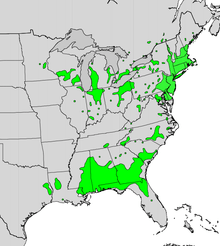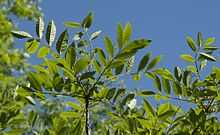Toxicodendron vernix
| Poison sumac | |
|---|---|
 | |
| Poison sumac leaves | |
| Scientific classification | |
| Kingdom: | Plantae |
| (unranked): | Angiosperms |
| (unranked): | Eudicots |
| (unranked): | Rosids |
| Order: | Sapindales |
| Family: | Anacardiaceae |
| Genus: | Toxicodendron |
| Species: | T. vernix |
| Binomial name | |
| Toxicodendron vernix Kuntze | |
 | |
Toxicodendron vernix, commonly known as Poison sumac, is a woody shrub or small tree growing to 9 m (30 ft) tall.[1][2] It was previously known as Rhus vernix. All parts of the plant contain a resin called urushiol that causes skin and mucous membrane irritation to humans. When burned, inhalation of the smoke may cause the rash to appear on the lining of the lungs, causing extreme pain and possibly fatal respiratory difficulty.
Description
Poison sumac is a shrub or small tree, growing up to nearly 30 feet in height. Each pinnate leaf has 7–13 leaflets, each of which is 2–4 inches long. These are oval-to-oblong; acuminate (tapering to a sharp point); cuneate (wedge-shaped) at the base; undulate (wavy-edged); with an underside that is glabrous (hairless) or slightly pubescent (down-like hair) beneath.
Its flowers are greenish, growing in loose axillary panicles (clusters) 3–8 inches long. The fruits are subglobose (not quite spherical), gray, flattened, and about 0.2 inches across.

Distribution
Poison sumac grows exclusively in very wet or flooded soils, usually in swamps and peat bogs, in the eastern United States and Canada.[3]
Toxicity
In terms of its potential to cause urushiol-induced contact dermatitis, poison sumac is far more virulent than its relatives poison ivy and poison oak. According to some botanists, poison sumac is the most toxic plant species in the United States (Frankel, 1991).
The dermatitis shows itself in painful and long continued swellings and eruptions.[1] In the worst case, smoke inhaled by burning poison sumac leaves results in a medical condition pulmonary edema whereby blood enters lungs and the victim dies of suffocation.[4]

Notes
- ↑ 1.0 1.1 Keeler, Harriet L. (1900). Our Native Trees and How to Identify Them. New York: Charles Scribner's Sons. pp. 94–96.
- ↑ Rucker, Colby. "Tall Trees of Maryland". Maryland's Tallest Native Tree Species. Retrieved 20 January 2012.
- ↑ USDA Natural Resources Conservation Service: Toxicodendron vernix
- ↑ Poison sumac: Facts to be known
References
- Frankel, Edward, Ph.D. 1991. Poison Ivy, Poison Oak, Poison Sumac and Their Relatives; Pistachios, Mangoes and Cashews. The Boxwood Press. Pacific Grove, Calif. ISBN 0-940168-18-9.
External links
- Poison ivy / oak / sumac in "The Medicinal Herb FAQ".
- The Poison Sumac Page—Photos and facts about poison sumac.
- Poison Oak at Wayne's Word.